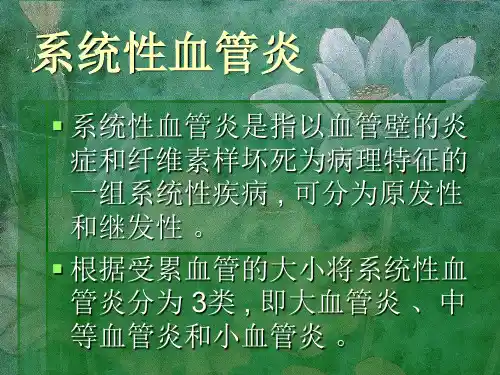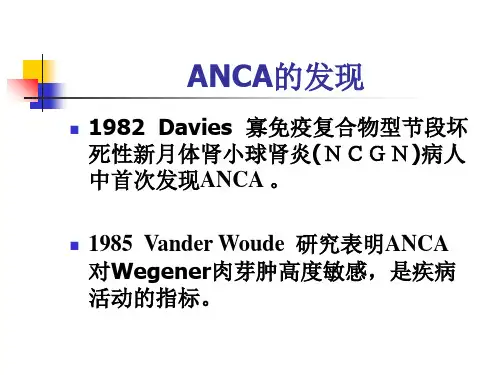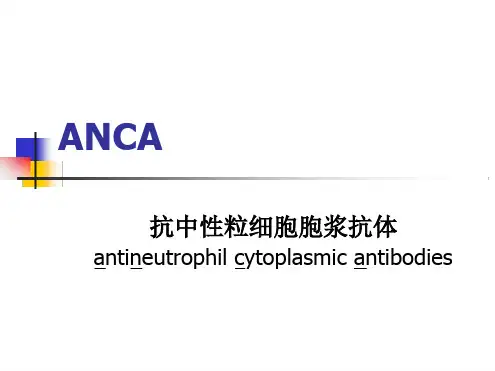抗中性粒细胞胞浆抗体 PPT课件
- 格式:ppt
- 大小:818.00 KB
- 文档页数:17


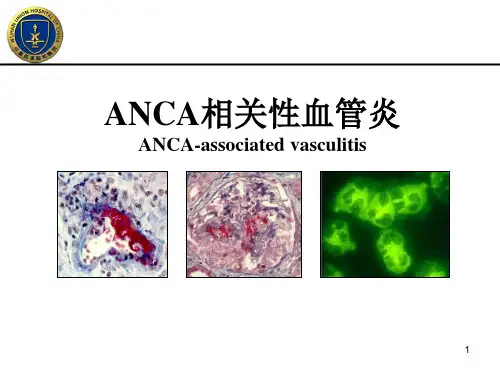

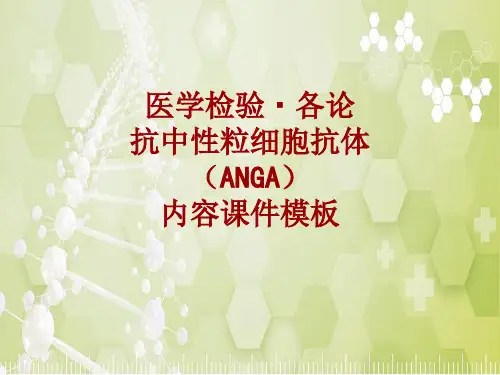

Human cANCA ELISA KitFor the quantitative in vitro determination of Human cytosolic anti-neutrophil cytoplasmicantibody concentrations inserum - plasma - celiac fluid - tissue homogenate - body fluidFOR LABORATORY RESEARCH USE ONLY.NOT FOR USE IN DIAGNOSTIC PROCEDURES.This package insert must be read in its entirety before using thisproduct.ELISAENZYME LINKED IMMUNOSORBENT ASSAY INTENDED USE AND TEST PRINCIPLEThis cANCA ELISA kit is intended Laboratory for Research use only and is not for use in diagnostic or therapeutic procedures. The Stop Solution changes the color from blue to yellow and the intensity of the color is measured at 450 nm using a spectrophotometer. In order to measure the concentration of cANCA in the sample, this cANCA ELISA Kit includes a set of calibration standards. The calibration standards are assayed at the same time as the samples and allow the operator to produce a standard curve of Optical Density versus cANCA concentration. The concentration of cANCA in the samples is then determined by comparing the O.D. of the samples to the standard curve.SAMPLE COLLECTION AND STORAGESSerum - Use a serum separator tube and allow samples to clot for 2 hours at room temperature or overnight at 4℃ before centrifugation for 20 minutes at approximately 2000×g. Remove serum and assay immediately or aliquot and store samples at -20℃. Avoid repeated freeze-thaw cyclesPlasma - Collect plasma using heparin as an anticoagulant. Centrifuge samples for 30 minutes at 2000×g at 2-8℃within 30 minutes of collection. Store samples at -20℃. Avoid repeated freeze-thaw cycles.Cell culture supernates, tissue homogenate and other biological fluids -Remove particulates by centrifugation and assay immediately or aliquot and store samples at -20℃.Avoid repeated freeze-thaw cycles.Note: The samples shoule be centrifugated dequately and no hemolysis or granule was allowed.MATERIALS REQUIRED BUT NOT SUPPLIED1. 37 ℃ incubator2. Standard microplate reader capable of measuring absorbance at 450 nm3. Precision pipettes, disposable pipette tips and Absorbent paperName96 determinations48 determinationsMicroelisa stripplate12*8strips12*4stripsStandard(6 vial)0.5ml/vial0.5ml/vialSample diluent 6.0ml 3.0mlHRP-Conjugate reagent10.0ml 5.0ml20X Wash solution25ml15mlChromogen Solution A 6.0ml 3.0mlChromogen Solution B 6.0ml 3.0mlStop Solution 6.0ml 3.0mlClosure plate membrane22User manual11Sealed bags11Note:1. Standard concentration was followed by: 2400、1200、600、300、150、75 pg/mL.2. If samples generate values higher than the highest standard, please dilute thesamples with Sample Diluent and repeat the assay.PRECAUTIONSDo not substitute reagents from one kit lot to another. Standard, conjugate and microtiter plates are matched for optimal performance. Use only the reagents supplied by manufacturer.Allow kit reagents and materials to reach room temperature (20-25°C) before use. Do not use water baths to thaw samples or reagents.Do not use kit components beyond their expiration date.Use only deionized or distilled water to dilute reagents.Do not remove microtiter plate from the storage bag until needed. Unused strips should bedisease. Disposable gloves must be worn during the assay procedure, since no known test method offer complete assurance that products derived from Rat blood will not transmit infectious agents. Therefore, all blood derivatives should be considered potentially infectious and good laboratory practices should be followed.All samples should be disposed of in a manner that will inactivate viruses.Liquid Waste: Add sodium hypochlorite to a final concentration of 1.0%. The waste should be allowed to stand for a minimum of 30 minutes to inactivate the viruses before disposal.Substrate Solution is easily contaminated. If bluish prior to use, do not use.Substrate B contain 20% acetone, keep this reagent away from sources of heat or flame.Remove all kit reagents from refrigerator and allow them to reach room temperature ( 20-25°C).REAGENT PREPARATION AND STORAGEWash Solution (1X) - Dilute 1 volume of Wash solution (20X) with 19 volumes of deionized or distilled water. Wash Solution is stable for 1 month at 2-8°C.ASSAY PROCEDUREPrepare all reagents before starting assay procedure. It is recommended that all Standards and Samples be added in duplicate to the Microelisa Stripplate.2. Add 50μl of Standard or Sample to the appropriate wells. Blank well doesn’t add anyting.3. Add 100μl of HRP-conjugate reagent to standard wells and sample wells except the blank well, cover with an adhesive strip and incubate for 60 minutes at 37°C.4. Wash the Microtiter Plate 4 times.Manual Washing - Remove incubation mixture by aspirating contents of the plate into a sink or proper waste container. Using a squirt bottle, fill each well completely with Wash Solution (1X),Automated Washing - Aspirate all wells, then wash plates four times using Wash Buffer (1X). Always adjust your washer to aspirate as much liquid as possible and set fill volume at 350μL/well/wash. After final wash, invert plate, and blot dry by hitting plate onto absorbent paper or paper towels until no moisture appears.5. Add chromogen solution A 50μl and chromogen solution B 50μl to each well. Gently mix and incubate for 15 minutes at 37°C. Protect from light.50μl Stop Solution to each well. The color in the wells should change from blue to yellow. If the color in the wells is green or the color change does not appear uniform, gently tap the plate to ensure thorough mixing.Read the Optical Density (O.D.) at 450 nm using a microtiter plate reader within 15 minutes.CALCULATION OF RESULTSThis standard curve is used to determine the amount in an unknown sample. The standard curve is generated by plotting the average O.D. (450 nm) obtained for each of the six standard concentrations on the vertical (X) axis versus the corresponding concentration on the horizontal (Y) axis.First, calculate the mean O.D. value for each standard and sample. All O.D. Values are subtracted by the mean value of the balnk well before result interpretation. Construct the standard curve using graph paper or statistical software.To determine the amount in each sample, first locate the O.D. value on the Y-axis and extend a horizontal line to the standard curve. At the point of intersection, draw a vertical line to the X-axis and read the corresponding concentration.Any variation in operator, pipetting and washing technique, incubation time or temperature, and kit age can cause variation in result. Each user should obtain their own standard curve.Intra-assay CV(%) and Inter-assay CV(%)are less than 15%.Assay range: 75 pg/mL – 2400 pg/mL.7. Sensitivity: The minimum detectable dose of Human cANCA is typically less than 10 pg/mL.8. Cross-reactivity: This assay recognizes recombinant and natural Human cANCA. Nosignificant cross-reactivity or interference was observed.9. Storage: 2-8℃ (Use frequently); six months (-20℃)。
